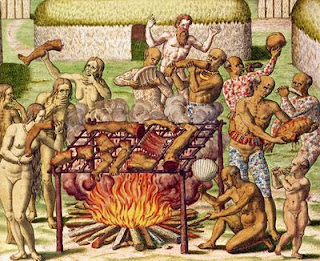THE MYTH OF THE NOBLE/GOOD SAVAGE ( 1 )
The myth of the good savage
1. A noble savage is a literary stock character who embodies the concept of the indigene, outsider, wild human, an "other" who has not been "corrupted" by civilization, and therefore symbolizes humanity's innate goodness. Besides appearing in many works of fiction and philosophy, the stereotype was also heavily employed in early anthropological works.
In English, the phrase first appeared in the 17th century in John Dryden's heroic play The Conquest of Granada (1672), wherein it was used in reference to newly created man. "Savage" at that time could mean "wild beast" as well as "wild man".The phrase later became identified with the idealized picture of "nature's gentleman", which was an aspect of 18th-century sentimentalism. The noble savage achieved prominence as an oxymoronic rhetorical device after 1851, when used sarcastically as the title for a satirical essay by English novelist Charles Dickens, who some believe may have wished to disassociate himself from what he viewed as the "feminine" sentimentality of 18th and early 19th-century romantic primitivism.
2.
 |
The myth says that savages were canibalists
|
 |
| But they are also know for their empathy |
3.
 |
The brand Banania, created in 1914, leaves the Caribbean of its first posters. From 1915 she identified itself with a hilarious Senegalese rifleman and adopted as a slogan "Y'a bon", associated with the summary French practice of the latter since 1913.
Created in 1857, the body of Senegalese riflemen has 31,000 men in 1914, all recruited in French
West Africa. They serve in Morocco from 1908 and, July 14, 1913, parade for the first time in Paris, where they make a sensation.
West Africa. They serve in Morocco from 1908 and, July 14, 1913, parade for the first time in Paris, where they make a sensation.
The creation of a "Black Force" restoring parity between the French and German armies, however, remains in the draft stage, and it was not until 1916 that the Senegalese skirmishers are massively engaged on the metropolitan front. In total, more than 134,000 of them came to fight in Europe, including 100,000 recruited between 1916 and 1918.

OK!
ReplyDeleteYou still need to complete your 'classmates' blog list'. Same for 'My teacher's blog'!
ReplyDeletePlease do it ASAP.
The 'pages' still go missing!
ReplyDeleteANGÈLE
ReplyDeleteBLOG POST 1: The MYTH of the NOBLE/GOOD SAVAGE
--> CONTENT (Questions 1 & 3): 5/10
--> FORM (Question 2, including post design, layout and pictures + language): 8/10
Total: 13/20 Serious but the third question is not really addressed. It’s a real pity!